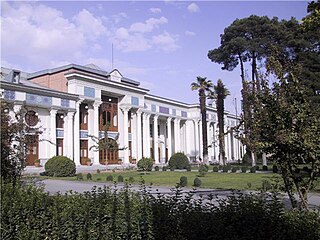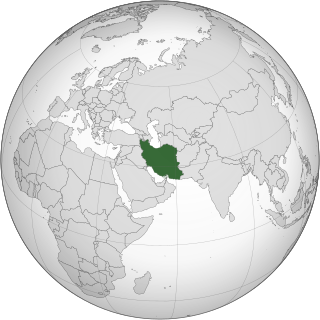Related Research Articles

Tehran is the capital and largest city of Iran and the largest city in Tehran Province. With a population of around 9 million in the city and around 16 million in the larger metropolitan area of Greater Tehran, Tehran is the most populous city in Iran and Western Asia, and has the second-largest metropolitan area in the Middle East, after Cairo. It is ranked 24th in the world by metropolitan area population.

The University of Tehran is the oldest and most prominent Iranian university located in Tehran, Iran. Based on its historical, socio-cultural, and political pedigree, as well as its research and teaching profile, UT has been nicknamed "The Mother University [of Iran]". In international rankings, UT has been ranked as one of the best universities in the Middle East and is among the top universities of the world. It is also the premier knowledge producing institute among all OIC countries. Tehran University of Medical Sciences is in the 7th ranking of the Islamic World University Ranking in 2021. The university offers more than 111 bachelor's degree programs, 177 master's degree programs, and 156 PhD. programs. Many of the departments were absorbed into the University of Tehran from the Dar al-Funun established in 1851 and the Tehran School of Political Sciences established in 1899.

Tehran province is one of the 31 provinces of Iran. It covers an area of 18,814 square kilometres (7,264 sq mi) and is located to the north of the central plateau of Iran.

The Grand Bazaar is an old historical bazaar in Tehran, Iran. It is split into several corridors over 10 kilometres (6.2 mi) in length, each specializing in different types of goods, and has several entrances, with Sabze-Meydan being the main entrance.

The Proto-Elamite period, also known as Susa III, is a chronological era in the ancient history of the area of Elam, dating from c. 3100 BC to 2700 BC. In archaeological terms this corresponds to the late Banesh period. Proto-Elamite sites are recognized as the oldest civilization in the territory of present-day Iran. The Proto-Elamite script is an Early Bronze Age writing system briefly in use before the introduction of Elamite cuneiform.

Baharestan is the name given to the historic Iranian parliament building, inaugurated in 1906. It was adopted from the name of the neighborhood and a small palace that adorned the place.
Tehranpars or Tehran Pars (تهرانپارس) is an absorbed city inside the Greater Tehran Area, located in the north east area of the city. It is considered a neighbourhood of Tehran City and lies in Tehran's eastern flank inside the area of the 4th and 8th municipalities of Tehran. In 1977, squatted areas in Tehranpars were evicted on the order of the state.

Touraj Daryaee is an Iranian Iranologist and historian. He currently works as the Maseeh Chair in Persian Studies and Culture and the director of the Dr. Samuel M. Jordan Center for Persian Studies at the University of California, Irvine.

Alireza Shapour Shahbazi was a prominent Persian archaeologist, Iranologist and a world expert on Achaemenid archaeology. Shahbazi got a BA degree in and an MA degree in East Asian archaeology from SOAS. Shahbazi had a doctorate degree in Achaemenid archaeology from University of London. Alireza Shapour Shahbazi was a lecturer in Achaemenid archaeology and Iranology at Harvard University. He was also a full professor of archaeology at Shiraz University and founded at Persepolis the Institute of Achaemenid Research in 1974. After the Islamic revolution, he moved to the US, firstly teaching at Columbia University and then later becoming a full professor of history in Eastern Oregon University.
Vyšný Čaj is a village and municipality in Košice-okolie District in the Košice Region of eastern Slovakia.

The Qom River or Qom Roud is a large river in Iran that receives its water from the Zagros Mountains and mounds into the Namak Lake. The Qom River flows through the city of Qom, and together with the Qareh Su it gains a length of approximately 400 km (250 mi). The water level strongly fluctuates between 312 m³/s and only 4 m³/s. This is partially the effect of taking water for irrigation.
Maranak is a village near the city of Damavand, Iran, located in Tehran. It is the site of an ancient Jewish cemetery. The original name of this place is Marānak. In 2004, the village was the location of a program to teach young Iranian students about the Internet and other computer technologies.
The 2009–10 Hazfi Cup was the 23rd season of the Iranian football knockout competition. Zob Ahan Isfahan was the defending champion.

Varuzh Karim-Masihi is an Iranian-Armenian film director, film editor, and screenplay writer.
Žerađe is a village in the municipality of Raška, Serbia. According to the 2002 census, the village has a population of 151 people.
Jaber Ebne Hayyan Pharmaceutical Company engages in manufacture and sale of injection and oral antibiotics, ointments, inhalers, nasal sprays & pearls. The company was formerly known as Squibb Iran and changed its name in 1979. Jaber Ebne Hayyan Pharmaceutical Company was founded in 1960 and is based in Tehran, Iran. The company is public joint stock and member of Tehran Stock Exchange with the registered capital of 378,000,000,000 rials.


Squatting in Iran mostly occurs around the major cities, as rural migrants move to urban centres. From the 1950s onwards shanty towns have been set up and inhabitants are known as "koukhnishinan". Following the Iranian Revolution of 1979, squatter settlements increased, with the state sometimes evicting and sometimes legalizing the areas.
The 2021-22 Hazfi Cup is the 35th season of the Iranian football knockout competition. Nassaji Mazandaran won the competition after defeating Aluminium Arak in the final.

The Alaviyan Dome is a 12th century mausoleum in Hamadan, Iran. A green colored dome once decorated the top of the building, as the poet Khaqani refers to be building as "the green dome", but has been destroyed by the passing of time.
References
- ↑ Aminian, Mahdi; Ghaffari, Masoud (2020). "How the Poor Become Revolutionaries: Suburbanites and Squatters of Tehran in Islamic Revolution of Iran". International Journal of Economics and Politics. 1 (2): 199–214. doi: 10.29252/jep.1.2.199 . S2CID 234736320.